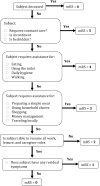Association between Cerebral Performance Category, Modified Rankin Scale, and discharge disposition after cardiac arrest
- PMID: 21524837
- PMCID: PMC3138855
- DOI: 10.1016/j.resuscitation.2011.03.034
Association between Cerebral Performance Category, Modified Rankin Scale, and discharge disposition after cardiac arrest
Abstract
Background: Cerebral Performance Category (CPC), Modified Rankin Scale (mRS) and discharge disposition are commonly used to determine outcomes following cardiac arrest. This study tested the association between these outcome measures.
Methods: Retrospective chart review of subjects who survived to hospital discharge between 1/1/2006 and 12/31/2009 was conducted. Charts were reviewed for outcomes (CPC, mRS, and discharge disposition). Discharge disposition was classified in 6 categories: home with no services, home with home healthcare, acute rehabilitation facility, skilled nursing facility, long term acute care facility, and hospice. Intra-and inter-rater reliabilities were calculated for outcome measures. Rates of "good outcome" (defined as a CPC of 1-2, mRS of 0-3, or discharge disposition to home or acute rehabilitation facility) were also determined. Kendall's tau correlation coefficients explored relationships among measures.
Results: A total of 211 charts were reviewed. Mean age was 60 years (SD 16), the majority (75%) were white males, in- and out-of hospital cardiac arrests were equally prevalent, and ventricular dysrhythmia was most common (N=109, 52%). Half of the subjects were comatose following resuscitation and 75 (35%) received therapeutic hypothermia. Inter-rater percentage agreement for CPC and mRS abstraction was 95.24% (kappa 0.89, p<0.001) and 95.24% (kappa 0.90, p<0.001) respectively. "Good outcomes" were found in 44 subjects (20%) using the CPC definition, 47 subjects (22%) using the mRS definition, and 129 subjects (61%) subjects using discharge disposition definition. There was fair relationship between the CPC and mRS (tau 0.43) and poor relationships between CPC and discharge disposition (tau 0.23) and between mRS and discharge disposition (tau 0.25).
Conclusions: Determination of the CPC, mRS and discharge disposition at hospital discharge is reliable from chart review. These instruments provide widely differing estimates of "good outcome". Agreement between these measures ranges from poor to fair. A more nuanced outcome measure designed for the post-cardiac arrest population is needed.
Copyright © 2011 Elsevier Ireland Ltd. All rights reserved.
Conflict of interest statement
The authors have no conflicts of interest to report.
Figures




References
-
- Brain Resuscitation Clinical Trial I Study Group (BRCT-1) Randomized clinical study of thiopental loading in comatose survivors of cardiac arrest. N Engl J Med. 1986;314:397–403. - PubMed
-
- Jennett B, Bond M. Assessment of outcome after severe brain damage. Lancet. 1975;1:480–4. - PubMed
-
- Cummins RO, Chamberlain D, Hazinski MF, et al. Recommended guidelines for reviewing, reporting, and conducting research on in-hospital resuscitation: the in-hospital ‘Utstein Style’: a statement for healthcare professionals from the American Heart Association, the European Resuscitation Council, the Heart and Stroke Foundation of Canada, the Australian Resuscitation Council, and the Resuscitation Councils of Southern Africa. Circulation. 1997;95:2213–9. - PubMed
-
- Van Swieten JC, Koudstaal PJ, Visser MC, Schouten HJA, Van Gijn J. Interobserver agreement for the assessment of handicap in stroke patients. Stroke. 1988;19:604–7. - PubMed
Publication types
MeSH terms
Grants and funding
LinkOut - more resources
Full Text Sources
Medical

